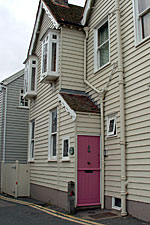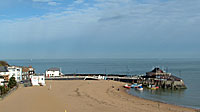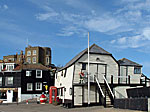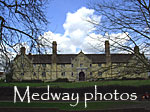Frank's travels around Britain 2007.
Medway & East
Grinstead
I tried to do the research about the area before I went, only to find out that Whitstable was a disappointment, Broadstairs very nice (that was found out through chatting to people) & East Grinstead fascinating!
I have never
eaten oysters. In the early nineteenth century, oysters were very cheap and were
mainly eaten by the working classes. Whitstable is world famous for them & when I found
out how much they cost ... I still haven't tried oysters! The
oysters, formerly harvested offshore
and are still served in restaurants in the town at enormous expense (I think they
were £16 plus for half a dozen at one posh place). Whitstable Oyster Fishery
Company is one of Europe's oldest commercial ventures, and its oysters were
exported across the
Roman Empire during the Roman
occupation of Britain. Whitstable has its own oyster festival that takes place
in July and is one of, if not the most, prominent oyster festivals in England.
have never
eaten oysters. In the early nineteenth century, oysters were very cheap and were
mainly eaten by the working classes. Whitstable is world famous for them & when I found
out how much they cost ... I still haven't tried oysters! The
oysters, formerly harvested offshore
and are still served in restaurants in the town at enormous expense (I think they
were £16 plus for half a dozen at one posh place). Whitstable Oyster Fishery
Company is one of Europe's oldest commercial ventures, and its oysters were
exported across the
Roman Empire during the Roman
occupation of Britain. Whitstable has its own oyster festival that takes place
in July and is one of, if not the most, prominent oyster festivals in England.
As with a lot of the tourist towns, Whitstable has huge numbers of charity shops, many shops selling stuff you didn't know you needed at a prices you didn't know could be that high and often full of ladies who lunch/shop/look fairly harassed. It has its fair share of art shops with art to make you go weak at the prices. The town's historic harbour, was built in 1832 to serve the world's first passenger railway service. Nicknamed the Crab and Winkle line, it linked Canterbury to London via a steam ship from the harbour.
As usual, I got talking to someone & they said, "You'd like Broadstairs!" And
they were right.
 The
town lies above a
harbour,
historically known for
smuggling.
Some 20 miles from both
Dover and
Canterbury,
it is a popular resort for day-trippers and holidaymakers. It has seven sandy
bays, which are Viking Bay, Louisa Bay, Kingsgate Bay, Dumpton Gap, Botany Bay,
Stone Bay and Joss Bay. I learnt this after I left! I think its worth revisiting
for a coast walk. I guess Broadstairs has changed very little over the past
fifty years, that will bring visitors back time and again. Its has a bygone feel
about. Rather old fashioned in a very nice way. It makes a big fuss of its
historical connections with smugglers,
Queen Victoria
spending many summers in Broadstairs as a child, the Napoleonic Eagle Standard
being landed here after the battle of Waterloo & of course, Charles Dickens was
a frequent visitor.
Bleak House,
where he wrote
David Copperfield,
towers above the town. There is a legend that if you leave a note for Dickens in
the top drawer of the writing desk in what used to be his study, he will come
during the night to read it. Another house in the town, called Dickens house, is
where the character of Betsy Trotwood, from David Copperfield, once lived. The
full title was "David Copperfield or The Personal History, Adventures,
Experience and Observation of David Copperfield the Younger of Blunderstone
Rookery (which he never meant to be published on my account)" Catchy eh?
The
town lies above a
harbour,
historically known for
smuggling.
Some 20 miles from both
Dover and
Canterbury,
it is a popular resort for day-trippers and holidaymakers. It has seven sandy
bays, which are Viking Bay, Louisa Bay, Kingsgate Bay, Dumpton Gap, Botany Bay,
Stone Bay and Joss Bay. I learnt this after I left! I think its worth revisiting
for a coast walk. I guess Broadstairs has changed very little over the past
fifty years, that will bring visitors back time and again. Its has a bygone feel
about. Rather old fashioned in a very nice way. It makes a big fuss of its
historical connections with smugglers,
Queen Victoria
spending many summers in Broadstairs as a child, the Napoleonic Eagle Standard
being landed here after the battle of Waterloo & of course, Charles Dickens was
a frequent visitor.
Bleak House,
where he wrote
David Copperfield,
towers above the town. There is a legend that if you leave a note for Dickens in
the top drawer of the writing desk in what used to be his study, he will come
during the night to read it. Another house in the town, called Dickens house, is
where the character of Betsy Trotwood, from David Copperfield, once lived. The
full title was "David Copperfield or The Personal History, Adventures,
Experience and Observation of David Copperfield the Younger of Blunderstone
Rookery (which he never meant to be published on my account)" Catchy eh?
E ast
Grinstead is a crap name & a gem of a place! Religion is big here.
ast
Grinstead is a crap name & a gem of a place! Religion is big here. There is a strange co-incidence in that a number of religious organisations
being headquartered in the town prompted a documentary in 1994, Why East
Grinstead?, which was produced for
Channel 4 by Zed Productions and
directed by Ian Sellar. The documentary didn't come to any definite conclusions:
the explanations ranging from the fact that East Grinstead sat on the
convergence of ley lines to the more prosaic idea that the various religious
inquirers had settled there because they liked the views. There are all the
usual churches plus, Kingdom Hall of Jehovah's Witnesses,
British headquarters of the Church of Scientology, Opus Dei, the Rosicrucian's &
Mormonís Temple.
There is a strange co-incidence in that a number of religious organisations
being headquartered in the town prompted a documentary in 1994, Why East
Grinstead?, which was produced for
Channel 4 by Zed Productions and
directed by Ian Sellar. The documentary didn't come to any definite conclusions:
the explanations ranging from the fact that East Grinstead sat on the
convergence of ley lines to the more prosaic idea that the various religious
inquirers had settled there because they liked the views. There are all the
usual churches plus, Kingdom Hall of Jehovah's Witnesses,
British headquarters of the Church of Scientology, Opus Dei, the Rosicrucian's &
Mormonís Temple.
The High Street contains the longest continuous run of 14th-century timber-framed buildings in England. Other notable buildings in the town include Sackville College, the sandstone almshouse built in 1609 where the Christmas carol "Good King Wenceslas" was written.
It is amazing to see the stones in
the churchyard. Anne Tree, Thomas Dunngate and John Forman were
burned as Martyrs on 18 July 1556 because they would not renounce the Protestant
Faith. They became the East Grinstead martyrs. The inscribed slabs in the
churchyard of St. Swithun's are only a memorial to them and that the ashes of
the martyrs do not lie underneath. It is not known where the actual remains are,
although it is thought that they are somewhere in the churchyard. There are some
ashes under the slabs but these were in fact dug up in the High Street early
this century.. People had been finding ashes as far back as the beginning of the
19th Century and each find give rise to the claim that these were the remains of
the martyrs. Clearly this was not so and Lady Musgrave, who was somewhat more
pious, arranged for the memorial slabs to be laid and inscribed. (Date not
known) It should also be remembered that they were burned as heretics, not
witches. At first you read the stones like each individual grave stone, top to
bottom, then it dawns on you that you read across all three stones & it all
makes sense. it reads:
inscribed slabs in the
churchyard of St. Swithun's are only a memorial to them and that the ashes of
the martyrs do not lie underneath. It is not known where the actual remains are,
although it is thought that they are somewhere in the churchyard. There are some
ashes under the slabs but these were in fact dug up in the High Street early
this century.. People had been finding ashes as far back as the beginning of the
19th Century and each find give rise to the claim that these were the remains of
the martyrs. Clearly this was not so and Lady Musgrave, who was somewhat more
pious, arranged for the memorial slabs to be laid and inscribed. (Date not
known) It should also be remembered that they were burned as heretics, not
witches. At first you read the stones like each individual grave stone, top to
bottom, then it dawns on you that you read across all three stones & it all
makes sense. it reads:
Beneath these stones | are interred | (as is believed)
the | ashes | of
Thomas Dunngate | Anne Tree | & John Forman
who were | burned | to death
in the high St.
East Grinstead
in 1536
for adherence | to the | reformed faith
fideles | usoue ad | mortem
Links for information on this page:
